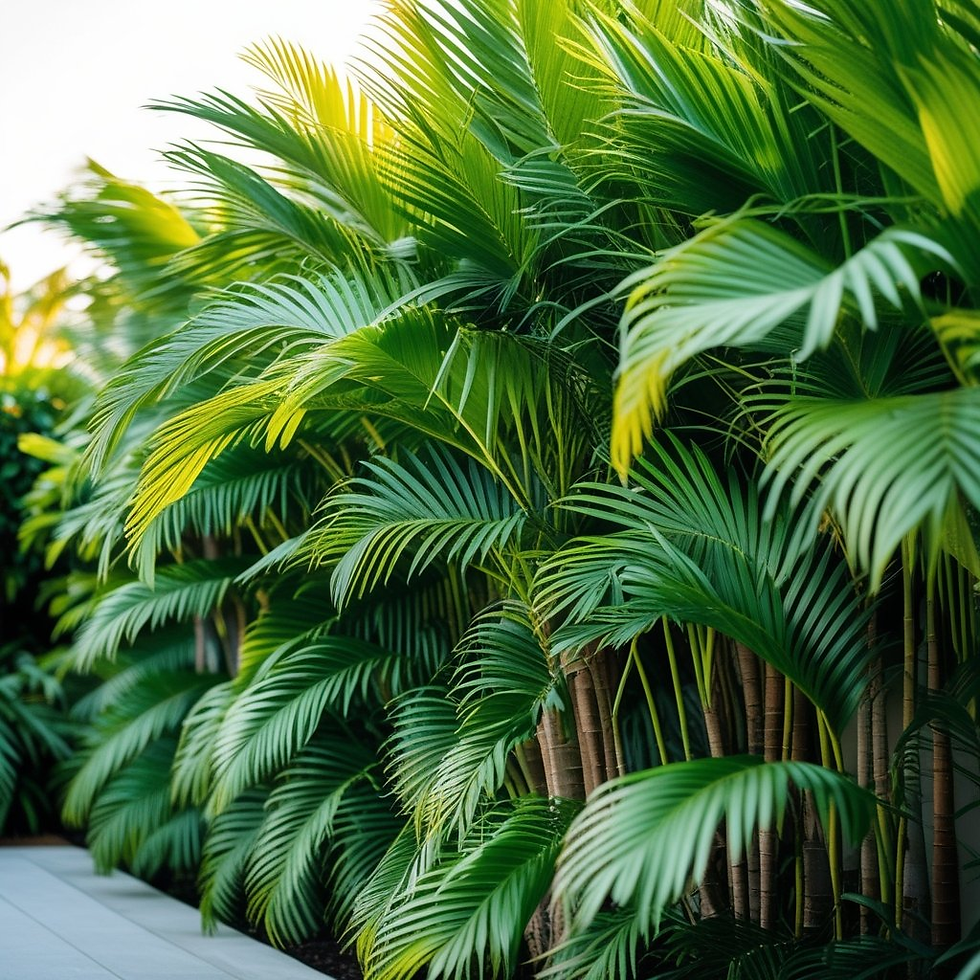Areca Palms for Privacy
- Jayant Upadhyay
- Jul 26
- 3 min read

Table of Contents:
Introduction
What Are Areca Palms?
Why Use Areca Palms for Privacy?
Benefits of Using Areca Palms as Privacy Screens
Growing Conditions and Requirements
How to Plant Areca Palms for Privacy
Best Layouts for Maximum Coverage
Maintenance Tips for Lush Growth
Common Issues and How to Fix Them
Areca Palms vs. Other Privacy Plants
Ideal Indoor and Outdoor Uses
Environmental Impact
Cost and Budgeting Tips
FAQs About Areca Palms for Privacy
Conclusion
1. Introduction
Privacy in residential and commercial landscapes is increasingly important. With urban homes getting smaller and neighbors closer, green solutions like Areca palms have gained popularity. This tropical plant not only beautifies spaces but also acts as a natural privacy screen. In this comprehensive guide, we explore why Areca palms are ideal for privacy, how to plant and maintain them, and how they compare to other options.
2. What Are Areca Palms?
Areca palm (Dypsis lutescens), also known as butterfly palm or golden cane palm, is a clumping palm native to Madagascar. With its lush, feathery fronds and multiple stems, it can grow 6-12 feet indoors and up to 20 feet outdoors. Its dense foliage makes it a superb natural screen, perfect for blocking views and reducing noise.
3. Why Use Areca Palms for Privacy?
Areca palms provide a beautiful and effective alternative to fences or artificial barriers. Their tall, bushy form offers year-round coverage. Because they grow in clusters, they form a thick wall of greenery. Plus, they are non-invasive, low-maintenance, and suitable for indoor and outdoor settings.
4. Benefits of Using Areca Palms as Privacy Screens
Aesthetic Appeal: Adds tropical elegance to any space
Noise Reduction: Dense foliage muffles sound
Air Purification: Known for improving indoor air quality
Low Maintenance: Requires less trimming than hedges
Non-Invasive Roots: Safe near foundations and walkways
Evergreen: Provides year-round privacy
5. Growing Conditions and Requirements
Light: Bright, indirect sunlight; partial shade outdoors
Soil: Well-draining, slightly acidic to neutral pH
Watering: Regular watering; keep soil moist but not soggy
Temperature: Prefers 65°F to 80°F; not frost-tolerant
Humidity: Thrives in humid conditions
6. How to Plant Areca Palms for Privacy
Spacing: Plant 3-6 feet apart for a continuous hedge
Depth: Dig a hole twice the width of the root ball
Mulching: Add mulch to retain moisture and suppress weeds
Watering After Planting: Water thoroughly and frequently during the first few weeks
7. Best Layouts for Maximum Coverage
Straight Line Hedge: Ideal for backyard boundaries
Staggered Rows: Creates a fuller, multi-dimensional screen
Corner Clusters: Perfect for patios and decks
Planter Arrangements: Great for balconies or small spaces
8. Maintenance Tips for Lush Growth
Pruning: Remove brown or yellowing fronds regularly
Fertilizing: Use palm-specific fertilizer 3-4 times a year
Pest Control: Watch for spider mites and mealybugs
Repotting (Indoors): Every 2-3 years to avoid root-bound plants
9. Common Issues and How to Fix Them
Yellow Leaves: Often caused by overwatering or nutrient deficiency
Browning Tips: Typically due to low humidity or salt buildup
Pests: Use neem oil or insecticidal soap
Root Rot: Ensure proper drainage to avoid waterlogging
10. Areca Palms vs. Other Privacy Plants
Feature | Areca Palm | Bamboo | Ficus | Leyland Cypress |
Growth Rate | Moderate | Fast | Fast | Fast |
Maintenance | Low | High | Moderate | Moderate |
Invasiveness | Low | High | Moderate | Low |
Looks | Tropical | Linear | Broadleaf | Coniferous |
Indoor Friendly | Yes | No | Yes | No |
11. Ideal Indoor and Outdoor Uses
Indoor: Near windows, in corners, entryways
Outdoor: Along fences, poolsides, patios, and balconies
Hybrid Spaces: Indoor/outdoor lounges and sunrooms
12. Environmental Impact
Carbon Footprint: Helps absorb CO2
Biodiversity: Attracts birds and insects
Sustainable Option: Reduces the need for artificial barriers
13. Cost and Budgeting Tips
Initial Cost: $20-$60 per plant depending on size
Installation: DIY or landscaper (budget $50-$200)
Maintenance Costs: Minimal (fertilizer, water, occasional pest control)
Long-Term Value: Increases property appeal and resale value
14. FAQs About Areca Palms for Privacy
How fast do Areca palms grow?
About 6-10 inches per year in ideal conditions.
Do they need direct sunlight?
No, they prefer bright but indirect light.
Are they safe for pets?
Yes, Areca palms are non-toxic to cats and dogs.
How often should I prune?
Only remove dead or damaged fronds as needed.
Can they survive winter?
Only in USDA zones 10-11; otherwise, bring indoors or cover during frost.
15. Conclusion
Areca palms are a natural, elegant, and effective solution for creating privacy in both residential and commercial landscapes. Their versatility, low maintenance, and aesthetic appeal make them a top choice in 2025 for eco-conscious homeowners and designers alike. Whether you're lining a backyard fence or styling a balcony, Areca palms offer sustainable beauty and practical coverage for years to come.



Comments